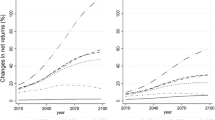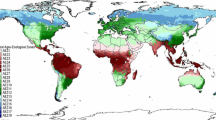Abstract
We integrate the combined agricultural production effects of forecasted changes in CO2, temperature and precipitation into a multi-regional, country-wide partial equilibrium positive mathematical programming model. By conducting a meta-analysis of 2103 experimental observations from 259 agronomic studies we estimate production functions relating yields to CO2 concentration and temperature for 55 crops. We apply the model to simulate climate change in Israel based on 15 agricultural production regions. Downscaled projections for CO2 concentration, temperature and precipitation were derived from three general circulation models and four representative concentration pathways, showing temperature increase and precipitation decline throughout most of the county during the future periods 2041–2060 and 2061–2080. Given the constrained regional freshwater and non-freshwater quotas, farmers will adapt by partial abandonment of agriculture lands, increasing focus on crops grown in controlled environments at the expense of open-field and rain-fed crops. Both agricultural production and prices decline, leading to reduced agricultural revenues; nevertheless, production costs reduce at a larger extent such that farming profits increase. As total consumer surplus also augments, overall social welfare rises. We find that this outcome is reversed if the positive fertilization effects of increased CO2 concentrations are overlooked.



Similar content being viewed by others
Notes
The effect of precipitation was already included in previous versions of the VALUE model (Kan and Rapaport-Rom 2012). For the present application, we updated precipitation forecasts for the periods under consideration.
We provide here a brief description of the data and meta-analysis; for a complete description see Zelingher (2017).
Due to its dry climate, croplands in Israel are not cultivated specifically as pasturelands for grazing, and livestock feed is mostly based on imported grains and locally produced fodder crops, which are incorporated in the model. Forests, centrally managed by the Jewish National Fund, are typically grown for various ecosystem services on lands with topography and soil quality that are unsuitable for crop production, and are not considered by MOARD as agricultural lands (Dr. Yael Kachel, MOARD, personal communication, July 2018). Thus, our analysis for the case of Israel excludes pasturelands and forestlands; nevertheless, these activities should be considered as substitutes to croplands in economic studies of climate-change agricultural effects in other regions (e.g., in Brazil; Alkimim et al. 2015).
“Future climate” refers to the conditions during the periods 2041–2060 and 2061–2080 in Israel as derived from the analysis of the GCMs in Sect. 2.2.
For six crops in the VALUE model (i.e., Other field crops, Other fruits, Other vegetables, Persimmon, Pomegranate, and Sweet potato), we could not retrieve a sufficient number of agronomic experiments to estimate a production function including all three climatic variables under investigation. For these crops, changes in future production were estimated using changes in precipitation only.
An “experiment” is thus defined here as a comparison between crops grown under identical conditions with the exception of CO2 and temperature levels.
GCMs were originally designed to simulate the earth’s climate. When using downscaled climate data, it is important to recall that the original information was generated at a coarse spatial resolution and did not take into account local topography or land cover patchiness, assuming homogeneity within each grid cell.
Therefore, projected temperatures and precipitation assume in our analysis 12 possible values (3 GCMs × 4 RCPs).
Except for the southern Negev region for which a radius of 50 km was used.
1 dunam = 1000 m2.
References
Alkimim A, Sparovek G, Clarke KC (2015) Converting Brazil’s pastures to cropland: an alternative way to meet sugarcane demand and to spare forestlands. Appl Geogr 62:75–84
Alpert P, Silverman D (2003) Vulnerability of water resources in eastern Mediterranean ecosystems due to climate change: an integrated approach to sustainable management. Paper presented at American Meteorological Society conference on impacts of water variability: benefits and challenges, Long Beach, CA
Asseng S, Ewert F, Matre P et al (2014) Rising temperatures reduce global wheat production. Nat Clim Chang 5:143–147
Avetisyan M, Hertel T, Sampson G (2014) Is local food more environmentally friendly? The GHG emissions impacts of consuming imported versus domestically produced good. Environ Resour Econ 58:415–462
Becker N, Freeman S (2009) The economic value of old growth trees in Israel. For Policy Econ 11:608–615
Ben-Gai T, Bitan A, Manes A et al (1999) Temporal and spatial trends of temperature patterns in Israel. Theor Appl Climatol 64:163–177
Bentsen M, Nethke I, Debernard JB et al (2013) The Norwegian Earth System Model, NorESM1-M—Part 1: description and basic evaluation of the physical climate. Geosci Model Dev 6:687–720
Cai C, Yin X, He S et al (2016) Responses of wheat and rice to factorial combiations of ambient and elevated CO2 and temperature in FACE experiments. Glob Change Biol 22:856–874
Calzadilla A, Rehdanz K, Betts R et al (2013) Climate change impacts on global agriculture. Clim Change 120:357–374
De Salvo M, Begalli D, Signorello G (2013) Measuring the effect of climate change on agriculture: a literature review of analytical models. J Dev Agric Econ 5:499–509
Donoghue JR (1995) The effects of within-group covariance structure on recovery in cluster analysis: I. The bivariate case. Multivar Behav Res 30(2):227–254
Easterling WE, Aggarwal PK, Batima P et al (2007) Food, fibre and forest products. In: Parry ML, Canziani OF, Palutikof JP et al (eds) Climate change 2007: impacts, adaptation and vulnerability. Cambridge University Press, Cambridge
Fleischer A, Tsur Y (2009) The amenity value of agricultural landscape and rural-urban land allocation. J Agric Econ 60(1):132–153
Fleischer A, Lichtman I, Mendelsohn R (2008) Climate change, irrigation, and Israeli agriculture: will warming be harmful? Ecol Econ 65:508–515
Fuchs-Rubal H (2014) The effect of reforms in agricultural crop quotas on producers and consumers. Master thesis, The Hebrew University of Jerusalem (in Hebrew)
Gent PR, Danabasoglu G, Donner LJ et al (2011) The community climate system model version 4. J Clim 24:4973–4991
Hananel R (2010) Zionism and agricultural land: national narratives, environmental objectives, and land policy in Israel. Land Use Policy 27:1160–1170
Howitt RE (1995) Positive mathematical programming. Am J Agric Econ 77:329–342
IPCC (2014) Climate change 2014: synthesis report. Intergovernmental Panel on Climate Change (IPCC), Geneva
Israeli Ministry of Agriculture and Rural Development (2013) Wholesale Price Survey. http://www.moag.gov.il/yhidotmisrad/itzur_economy/Overview_Prices/Pages/prices.aspx (in Hebrew). Accessed 19 Dec 2018
Kan I, Rapaport-Rom M (2012) Regional blending of fresh and saline irrigation water: is it efficient? Water Resour Res 48:W07517
Kan I, Schwabe KA, Knapp KC (2002) Microeconomics of irrigation with saline water. J Agric Resour Econ 27(1):16–39
Kan I, Haim D, Rapaport-Rom M et al (2009) Environmental amenities and optimal agricultural land use: the case of Israel. Ecol Econ 68:1893–1898
Kan I, Finkelstein I, Rapaport-Rom M (2014) Simulations of changes in the agricultural trade policy using a computational equilibrium model. Paper presented at Seminar on studies in agricultural economics and rural development. Ministry of Agriculture and Rural Development, Jerusalem (in Hebrew)
Kislev Y (2011) The water economy of Israel. Policy Program Paper, Taub Center for Social Policy Studies in Israel, Jerusalem
Likhtman E (2006) The impact of climate change on the profitability of agricultural farms in Israel. Master thesis, The Hebrew University of Jerusalem (in Hebrew)
Lobell DB, Field CB (2007) Global scale climate-crop yield relationships and the impacts of recent warming. Environ Res Lett 2:1–7
Long SP, Noesberger J, Ainsworth EA et al (2006) Food for thought: lower-than-expected crop yield stimulation with rising CO2 concentrations. Science 312:1918–1921
Loumou C, Giourga C (2003) Olive groves: the life and identify of the Mediterranean. Agric Hum Values 20:87–95
Palatnik RR, Eboli F, Ghermandi A et al (2011) Integration of general and partial equilibrium agricultural land-use transformation for the analysis of climate change in the Mediterranean. Climate Change Econ 2(4):275–299
Peck DE, Adams RM, Dinar A et al (2012) Farm-level impacts of climate change: alternative approaches for modeling uncertainty. In: Dinar A, Mendelsohn RO (eds) Handbook on climate change and agriculture. Edward Elgar Publishing, Cheltenham
Rosenzweig C, Jones JW, Hatfield JL et al (2013) The Agricultural Model Intercomparison and Improvement Project (AgMIP): protocols and pilot studies. Agric For Meteorol 170:166–182
Schlenker W, Roberts MJ (2009) Nonlinear temperature effects indicate severe damages to US crop yields under climate change. Proc Natl Acad Sci 106(37):15594–15598
Schmid E, Sinabell F (2005) Using the positive mathematical programming method to calibrate linear programming models. Discussion Paper, University of Natural Resources and Applied Life Sciences, Vien
Shuval H (2013) The agricultural roots of Israel’s water crisis. In: Orenstein DE, Miller C, Tal A (eds) Between ruin and restoration: an environmental history of Israel, University of Pittsburgh Press. Pittsburgh, PA
Smith P, Bustamante M, Ahammad H et al (2014) Agriculture, forestry and other land use (AFOLU). In: Edenhofer O, Pichs-Madruga R, Sokona Y et al (eds) Climate Change 2014: Contribution of Working Group III to the Fifth Assessment Report of the Intergovernmental Panel on Climate Change, Cambridge University Press, Cambridge, UK and New York, NY, USA
Solow AR, Adams RF, Bryant KJ et al (1998) The value of improved ENSO prediction to U.S. agriculture. Clim Change 39:47–60
Tchetchik A, Fleischer A, Finkelshtain I (2008) Differentiation and synergies in rural tourism: estimation and simulation of the Israeli market. Am J Agric Econ 90(2):553–570
Teixeira EI, Fischer G, van Velthuizen H et al (2013) Global hot-spots of heat stress on agricultural crops due to climate change. Agric For Meteorol 170:206–215
Tielbörger K, Claus C, Schloz D et al (2016) Sustainable water and land management under global change. In: Borchardt D, Bogardi JJ, Ibisch RB (eds) Integrated water resources management: concept, research and implementation. Springer, Cham
Watanabe M, Suzuki T, O’ishi R et al (2010) Improved climate simulation by MIROC5: mean states, variability and climate sensitivity. J Clim 23:6312–6335
Yehoshua N, Shechter M (2003) Climate change and agriculture: an Israeli perspective. In: Giupponi C, Shechter M (eds) Climate change and the Mediterranean: socio-economic perspectives of impacts, vulnerability and adaptation. Edward Elgar, Cheltenham
Zelingher R (2017) Evaluating the economic impact of climate change on vegetative agriculture in Israel. Master thesis, The Hebrew University of Jerusalem
Acknowledgements
Funding was provided by the Center for Agricultural Economic Research, Department of Environmental Economics and Management, The Hebrew University of Jerusalem.
Author information
Authors and Affiliations
Corresponding author
Additional information
Publisher's Note
Springer Nature remains neutral with regard to jurisdictional claims in published maps and institutional affiliations.
Electronic Supplementary Material
Below is the link to the electronic supplementary material.
Rights and permissions
About this article
Cite this article
Zelingher, R., Ghermandi, A., De Cian, E. et al. Economic Impacts of Climate Change on Vegetative Agriculture Markets in Israel. Environ Resource Econ 74, 679–696 (2019). https://doi.org/10.1007/s10640-019-00340-z
Accepted:
Published:
Issue Date:
DOI: https://doi.org/10.1007/s10640-019-00340-z




